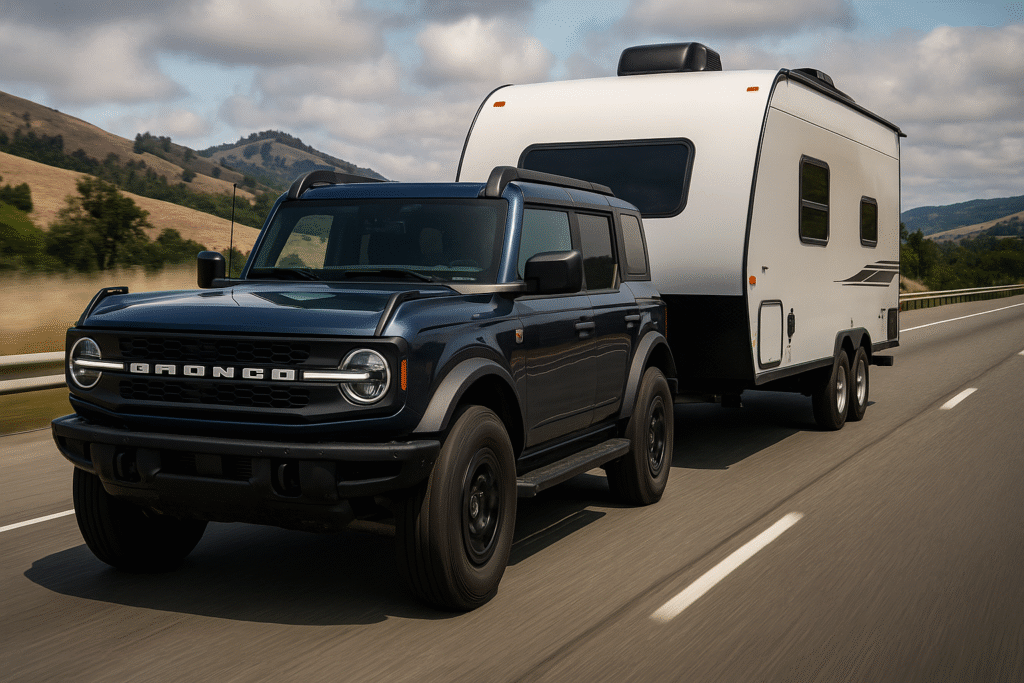The Ford Bronco has always been more than just an SUV. It is a symbol of adventure, outdoor exploration, and rugged capability. For many drivers, though, the appeal of the Bronco extends beyond off-road trails — it also lies in its ability to tow gear, trailers, and small campers for weekend getaways. That is where the Ford Bronco towing capacity becomes an important factor.
Understanding how much weight a vehicle can safely pull matters because it directly affects safety, performance, and even fuel efficiency. If you know the limits, you can make better decisions about what you can tow — whether it is a small fishing boat, a camper trailer, or extra equipment for family trips. In this guide, we will take a close look at how the Ford Bronco performs in terms of towing, how the numbers vary by trim level and engine, and how it compares to competitors in its class. By the end, you will have a clear idea of whether the Bronco fits your towing needs.
Understanding the Ford Bronco’s Towing Power
Towing power is not simply about attaching a trailer and hitting the road. Automakers calculate towing capacity using factors such as the engine’s strength, transmission, cooling systems, suspension setup, and braking ability. For the Bronco, Ford also considers frame strength and how the vehicle handles under load.
At its core, towing capacity represents the maximum weight a Bronco can safely tow without compromising stability or damaging its systems. That weight includes not just the trailer but also everything loaded on it. Another key term is tongue weight — the amount of force the trailer applies to the hitch. Keeping these numbers balanced ensures safe handling, especially at highway speeds or on uneven terrain.
The Ford Bronco is built with adventure in mind, so it naturally comes with respectable towing numbers. Still, not every Bronco can tow the same weight. Differences in engines, drivetrains, and packages make a noticeable impact, and that is why buyers should always check the details for the specific trim they choose.
Towing Capacity by Engine and Trim Levels
The Ford Bronco towing capacity varies across the lineup. Entry-level trims equipped with the standard 2.3-liter EcoBoost engine usually deliver towing ratings around 3,500 pounds, which is suitable for smaller trailers or recreational equipment. Step up to the more powerful 2.7-liter EcoBoost V6, and you will find that capacity remains similar on standard configurations but benefits from stronger torque, making towing smoother.
For those seeking maximum pulling power, the Bronco Raptor stands out. With its high-output 3.0-liter EcoBoost engine, reinforced suspension, and upgraded cooling systems, the Raptor is rated to tow up to 4,500 pounds. While that number is not massive compared to full-size trucks, it places the Bronco near the top among mid-size adventure SUVs.
Trim levels such as the Big Bend, Black Diamond, Badlands, and Wildtrak all share the same basic 3,500-pound rating when not equipped with the towing package. What sets them apart is how they handle different terrains. For example, the Badlands trim is tuned for extreme off-roading, meaning its suspension prioritizes articulation and durability. That focus ensures it can tow safely even on rough trails, though the raw number remains the same.
How the Towing Package Changes the Game?
One of the biggest differences in real-world towing comes from whether or not the Bronco is equipped with Ford’s towing package. This option adds hardware that significantly improves performance under load. It typically includes a Class II hitch receiver, upgraded wiring harness for trailer lights and brakes, and sometimes enhanced cooling systems.
While the base capacity for most trims is 3,500 pounds, the towing package ensures that weight can be pulled more confidently. The additional cooling and electrical support allow for longer trips and safer handling, especially when towing up steep grades or in hot weather. In short, the towing package does not just change numbers on paper — it changes the overall driving experience when hauling a trailer.
Drivers who plan to tow regularly will benefit from investing in this package, as it extends the Bronco’s practical usability. It also makes it easier to connect with trailer brake controllers, which become important once the load approaches the SUV’s limits.
Comparing the Bronco to Everyday Towing Needs
Numbers on a chart are helpful, but what does Ford Bronco towing capacity mean in real life? For the average driver, a 3,500-pound limit is enough for small to medium-sized trailers. This includes single-axle utility trailers for moving furniture or equipment, jet skis, small boats, and compact campers.
Families who enjoy camping may find this capacity perfectly suited for teardrop campers or lightweight travel trailers. On the other hand, those who plan to tow larger RVs, multi-axle trailers, or heavy boats may find the Bronco’s limits restrictive. In those cases, a full-size SUV or pickup truck would be better suited.
The Bronco Raptor, with its 4,500-pound rating, opens the door for slightly heavier setups. Still, it is not intended for hauling large horse trailers or big fifth-wheel campers. Instead, it provides just enough extra muscle for outdoor enthusiasts who need more flexibility than the base trims provide.
Ford Bronco vs. Key Competitors in Towing Strength
To understand where the Bronco stands, it helps to compare it with its closest rivals. Two of the most common alternatives are the Jeep Wrangler and the Toyota 4Runner, both popular among adventure-driven drivers.
Here is a simplified comparison:
| Vehicle | Standard Towing Capacity | Maximum Towing Capacity | Notes |
| Ford Bronco | 3,500 lbs | 4,500 lbs (Raptor) | Balanced towing power with modern off-road features |
| Jeep Wrangler | 2,000 lbs | 3,500 lbs (with towing package) | Similar base figures but less variety in higher trims |
| Toyota 4Runner | 5,000 lbs | 5,000 lbs | Stronger towing, but less modern off-road tech compared to Bronco |
From this comparison, the Bronco sits comfortably above the Wrangler in maximum capability but slightly behind the 4Runner when it comes to raw numbers. However, the Bronco makes up ground with advanced off-road technology and a more modern driving experience.
Safety and Best Practices for Towing With a Bronco
Towing is not only about what your SUV can pull; it is also about how safely you can manage the load. For Bronco owners, a few best practices go a long way. First, always confirm the trailer weight before setting off, and never exceed the official rating. Even being slightly over the limit can affect handling and braking distance.
Next, pay attention to weight distribution. Too much load at the back can cause swaying, while too much tongue weight can strain the suspension. Using a proper hitch, especially a weight-distributing model, helps balance these forces.
Brakes also play a key role. If your trailer exceeds 1,500 pounds, it should have its own braking system. Many states legally require this, and it also makes highway driving safer. Finally, remember that towing changes how the Bronco accelerates, turns, and stops. Leave extra distance between vehicles, and take corners slowly to keep control.
Conclusion
The Ford Bronco towing capacity reflects the SUV’s adventurous spirit while providing practical capability for everyday drivers. With a base capacity of 3,500 pounds across most trims and a maximum of 4,500 pounds in the Raptor, the Bronco is well-suited for small to medium towing tasks. It may not match the raw pulling power of larger SUVs like the Toyota 4Runner, but it balances capability with modern off-road performance and versatility.
For drivers who want a vehicle that handles trails as confidently as it handles towing, the Bronco is a compelling choice. Whether you are hauling a camper for a weekend escape or pulling a boat to the lake, the Bronco delivers a reliable mix of strength, stability, and safety — as long as you respect its limits.




